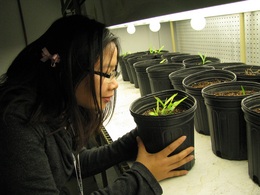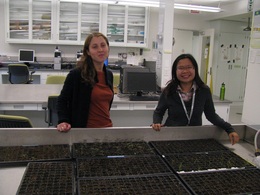|
|
We started out the day doing what we do best: searching for seedlings in Experimental Plot 8 (a.k.a. Q2). Having braved formidable winds to plant them late last October, Stuart, Gretel, and Ruth were visibly relieved to see them pop up this spring. Since last week Team Echinacea has been diligently tracking down each seedling and “naming” them with colored toothpicks and row location coordinates, accurate to one centimeter.
In the afternoon we located and counted Echinacea in the recruitment experiment, a continuation of the project described in this paper. The procedure is really fun: we find the boundaries of the plots with metal detectors, triangulate points, then search within an area exactly the size of a regulation 175-gram Disc-craft Ultra Star disc (a.k.a. frisbee). Go CUT!
The best part of the day was tagging my first Echinacea. Maybe it just lost its old tag, but I like to think this is the first time this plant has ever born the silver badge. Sometime 10-12 years ago, this seed was planted. Now that it is finally about to flower, it has the honor of going down in history in the databases of the Echinacea Project, living out the rest of its life in the service of science. This 23rd of June, 3.65 m from the southwest corner and 0.79 m from the southeast corner of the northeast plot in Recruit 9, I named a flowerstalk “19061.” Isn’t it beautiful?

Doesn’t the flower head look ripe? Stuart says we may start to see flowering as early as the end of this week!

Eventually the time came to leave my new friend and join the rest of the team. This is where they were:

(Can you spot the team?)
A nice day is Douglas County is a very nice day.
Something about springtime makes you more aware of the layers of grime covering every surface of your life. Thankfully, volunteers Leslie and Anne agreed to help us battle the accumulated dust throughout lab. Believe it or not, this is a vacuum cleaner, not a ghost-busting device.

Now that the lab is sparkling, clean, and free of ghosts, we can continue our scientific endeavors in a grime-free environment.
We have two interns pursuing independent projects in the lab. Jill Pastick, a junior at Lakeforest College, is testing out different methods of germinating Echinacea achenes and helping us prepare the germination phase of two ongoing experiments.

Gia Hallaman, a junior at Northwestern, is helping out with several projects, including counting achenes in x-ray images from Jill’s germination experiment (you can see them on the computer screen below). She is also learning how to identify ants to morphospecies. That means distinguishing different species based on morphology and making our best guess on which species they are. It takes time to develop an eye for the different traits that distinguish closely related species; often the most obvious traits, like color and size, are not informative for differentiating species. Jill is learning to use a combination of tools, including online dichotomous keys and photo databases (antweb.org), to identify ants to species or morphospecies. With her help, we should be able to make a dent in identifying the ants we collected from Minnesota prairie remnants in the summer of 2012.

This week we said goodbye to many of the students and volunteers who are traveling for the holiday season. Maria Wang left behind her dicanthelium to travel to visit with family in the UK. One of our volunteers, Bill W., is preparing for a trip to Panama. While a few people will be coming in next week, we won’t see most of our volunteers until next year. We’ve made a lot of progress in the past few months. Here is a brief summary of what we’ve accomplished since September:
1. New faces
We hosted several new interns this fall. Five students from Lakeforest College completed a four week internship on various projects (you can read about some of their work on the flog) . Marie (Carleton College) has been doing great work for an ongoing study on flowering phenology in prairie remnants. We will miss her when she goes back to school.
2. Lots and lots of counting
We have made a big dent in counting the achenes harvested in 2011 from the main experimental plot. We finished all counting for the 1999 experiment (4000s batch) and have begun counting for the rest of the 2011 harvest. And of course, no counting endeavor would be complete without a motivational whiteboard graphic.

3. New protocols
Because there are relatively few Echinacea heads to process from this year, we have an opportunity to try out different protocols and improve our methods. Our new protocol for selecting a random sample of seeds will improve our ability to assess pollination based on seed weight. We are also trying out new techniques for extracting seed heads and separating the dust.

That about sums it up. These details (protocols, cleaning, etc.) may seem minor, but they are important for creating reliable data.
We had a lot of people in the lab last week. On Wednesday, we had volunteers Kathryn Eber and Sam Goldman along with a group of interns from Lakeforest College:



The Lakeforest students will return for two more afternoons–or longer if they so choose.
In other news, we are nearly finished counting the seeds from the 4000s batch in the 2011 harvest. For this batch, we are trying out a new protocol for selecting a random sample of seeds to weigh. Volunteers Suzie and Susanne were the first to implement the protocol and have given us some good feedback.
Every year the Echinacea Project collects all of the flowering heads from the experimental plots and processes them in the lab. Considering this process managed and completed by different people every year, it is challenging to keep everything organized from year to year.
One of our goals this year is to wrap up data collection on Echinacea seed heads from 2009 to 2011. Last year, Northwestern students Karen Taira and Ricky Rivera spent many hours organizing data from 2009 and 2010. They solved a lot of mysteries, including mislabeled heads, mislabeled files, and files saved in weird places. Last week I picked up where they left off. We are down to one box of mysteries–seeds that still need to be scanned, counted, and weighed. Once we finish with this box, we will have all our data from 2009.

In other news, a class from Lakeforest College is coming to the Chicago Botanic Garden for a mini-internship program. Karen, Stuart, and I will all be mentoring students for the next few weeks in projects related to our research. We will introduce the students and update their progress on the flog.
Lastly, this week we said goodbye to volunteer Art Abt as he prepared for his winter migration to warmer climes. We will miss him and his expertise in seed weighing.
Suzanne Turner foing inventory on 2012 Echinacea harvest.

Bill Wallin Counting

Based on the flog, it may seem that the lab activity has been consumed with counting seeds and identifying ants. However, I should point out that there are some real live plants in the lab as well.
Maria has been lovingly tending her Dicanthelium plants that she germinated last fall. One of the perks of working at the Chicago Botanic Garden is the high-tech growth chamber that allows you to control light, temperature, and humidity on a programmed schedule. Maria has programmed the chamber to approximate fall in Minnesota.

Any one at CBG can use the growth chamber for their research. Anna Braum, a grad student at Northwestern, is growing host plants for her experiment on the parasitic plant Castilleja coccinea–also known as the indian paintbrush. Here she is watering her plants (with help from Maria).

|
|



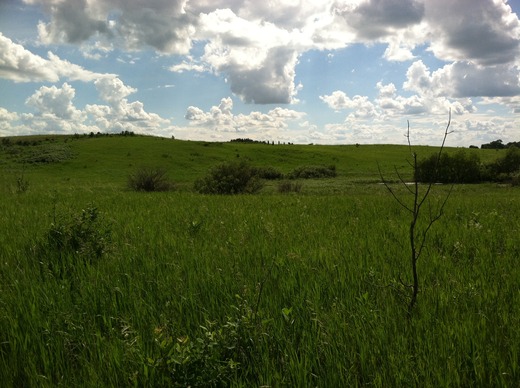
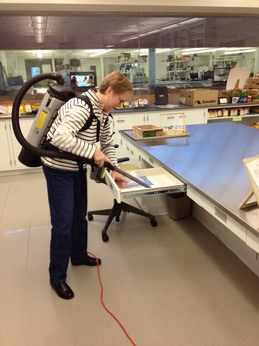
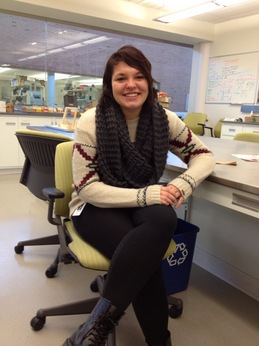
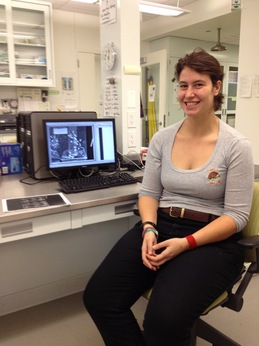
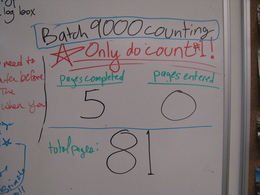

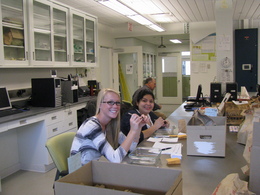
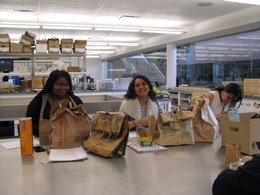

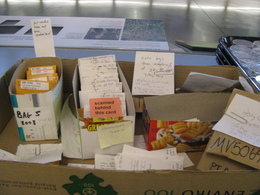
-thumb-260x195-136585.jpg)
-thumb-260x202-136579.jpg)
-thumb-260x202-136574.jpg)
